While the leaves of Venus Flytraps will grow and wither continuously during a growth cycle, the sight of black Venus Flytraps can be unsettling.
But don’t panic just yet, as some can be attributed to entirely natural causes while other reasons implicate improper Venus Flytrap plant care.
In this article, we’ll go over the most common reasons for your Venus flytrap turning black and find solutions to help you get rid of these problems once and for all.
Venus Flytrap Turning Black Overview
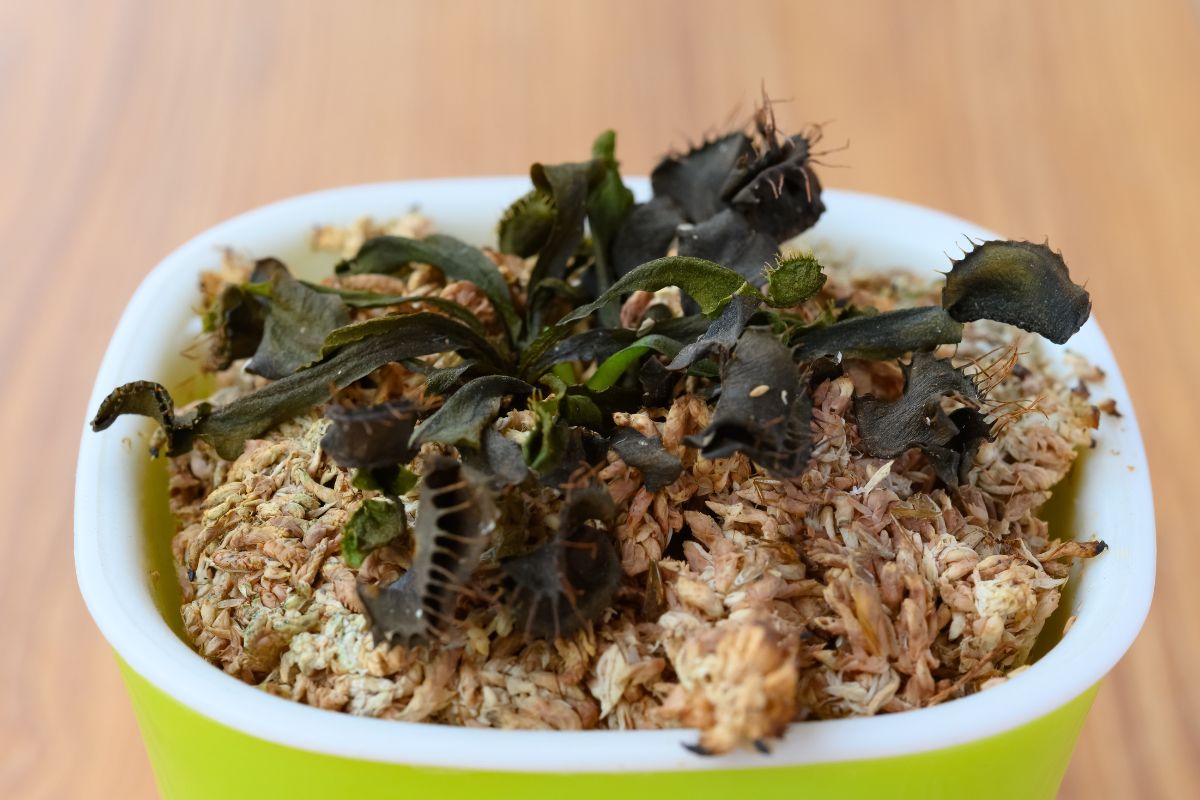
Venus Flytraps generally boast a bright green hue on trap exteriors while interiors are a vibrant red, so when a trap turns black it will probably give cause for worry. Black foliage can appear on a plant relatively often.
Growing, withering, and dying is a constant part of the plant’s growth cycle. However, if more than one trap turns black, it may be your plant’s cry for help.
Several traps turning black simultaneously indicate a problem with growing conditions, and there are quite a few factors that may be at the root of the problem.
Reasons For a Venus Flytrap Turning Black
It may be surprising how many reasons there are why a Venus Flytrap turns black. The most often seen causes include:
- Dormancy
- Extreme environmental temperatures
- Fertilizer use
- Improper feeding
- Improper growing medium or soil
- Inadequate light
- Incorrect watering
- Lack of humidity
- Natural life cycle
- Stress
- Water quality
Here we investigate why the traps on your plant are turning black and possible solutions when due to improper growing conditions.
Initially, your first task will be to determine if the black traps are part of the plant’s natural growth cycle, or if you need to modify some aspect of plant care.
1. Natural Causes
Regardless of what houseplant you are cultivating, the foliage will at some point wither, dry out, and die. This is common to all vegetation and can require only a few days or may happen over the course of weeks.
Venus Flytraps are no exception, and the traps or leaves can turn black due to improper growing conditions or because of natural causes.
Even if you are used to observing the traps’ bright green exteriors and vivid red interiors, know that it is normal that black leaves will appear at some point in your plant’s growth cycle. Black isn’t always a bad sign.
2. Natural Lifecycle
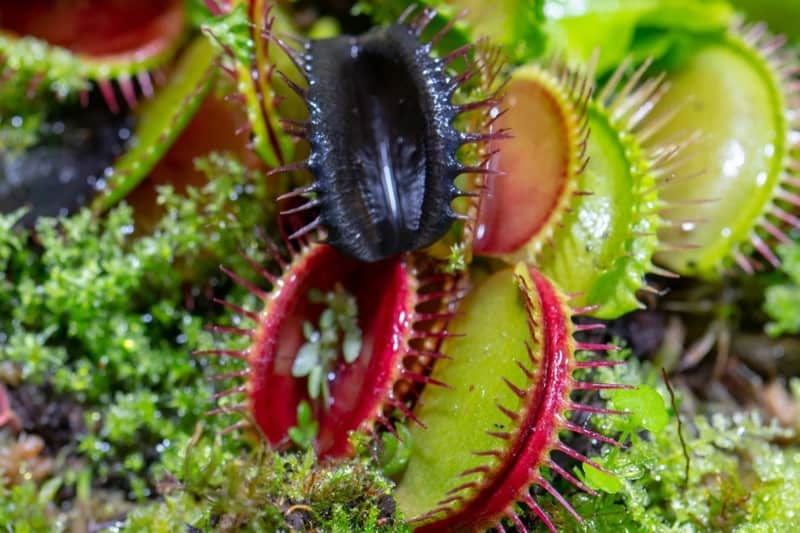
The traps of your Venus Flytrap will open and close a limited number of times before they wither and die. Usually around five times in the course of an individual trap’s life.
While each trap is unique, the process of leaves turning black is normal, and when they do begin to, you should note evidence of a new trap sprouting. All of your plant’s traps will go through this cycle, so do not worry about every black leaf you spot.
What you will want to note is if more than one leaf is dying at the same time, or if you do not see your plant sprouting new leaves or enough new leaves. In this case, there may be a problem with growing conditions or plant care that you need to resolve.
3. Winter Dormancy Period
The Venus Flytrap is characterized by the need for an annual period of dormancy. This will naturally take place during the winter when temperatures drop. The entire plant will go dormant and the appearance of black leaves during this period is completely normal.
Consider the period of the year when you see the black leaves. If the temperatures have already fallen to around 32° to 45°F outdoors, your plant will have entered dormancy.
Indoors, you should guide Venus Flytrap dormancy by placing your plant in an unheated location with a low temperature range, such as a garage, basement, or porch. Again, black leaves are to be expected and are normal.
If you still are not certain of whether your planting is hibernating or dead, you need to wait until the weather warms up when a living plant will awaken and leave dormancy.
Dormant Venus Flytraps do change slightly in appearance, but a dead plant may appear mushy as if rotting and will emanate an unpleasant odor. A sleeping plant may have several black leaves but will not smell or appear mushy.
4. Inappropriate Food
The natural evolution of the plant is for the consumption of bugs. Refrain from giving your plant human food such as raw meat, meat in general, fruit, or candy. They will not be able to digest human food and will waste lots of energy trying to do so.
When a Venus Flytrap cannot successfully digest food, it will abandon the cause and the trap will begin to wither, turning black.
Avoid using fertilizer with your Venus Flytrap. They have little to no tolerance for the salts used in fertilizers. Any fertilizer can cause mineral burn and the loss of leaves. Feed your plant bugs, rather than fertilizer.
5. Poor Growing Conditions
Soil
The wrong growing medium or soil type can also quickly kill these plants. Venus Flytraps must be grown in nutrient-free soil. This is to replicate the conditions of their natural habitats, which are wetlands and bogs that are of nutrient-poor soil. They are unable to survive in nutrient-rich or mineral-laden soil.
Never use standard potting soil as it will lead to the death of your plant. Use carnivorous plant soil that is usually a mix of sphagnum moss and a draining ingredient like sand or perlite.
The soil must be free of additives, or it will turn the plant black killing it. You can purchase carnivorous soil mix or the ingredients to mix it yourself.
Extreme Temperatures
While the Venus Fly Trap plant is resilient, extreme temperatures (cold and hot) can lead to foliage loss. In winter months, plants must never freeze completely and should not be exposed to temperatures lower than 20°F.
Summer temperatures of 100°F or more can dry up your plant, turning leaves black. If outdoors, bring your plant inside, or place it in partial shade, limiting extensive direct sunlight exposure.
Lack of Humidity
In arid climates, leaves may turn black. Try misting your plant to increase humidity or a pebble tray. In their natural habitats, Venus Flytraps enjoy high humidity year-round. They will still do well with humidity levels as low as 50%.
6. Overfeeding and Improper Feeding
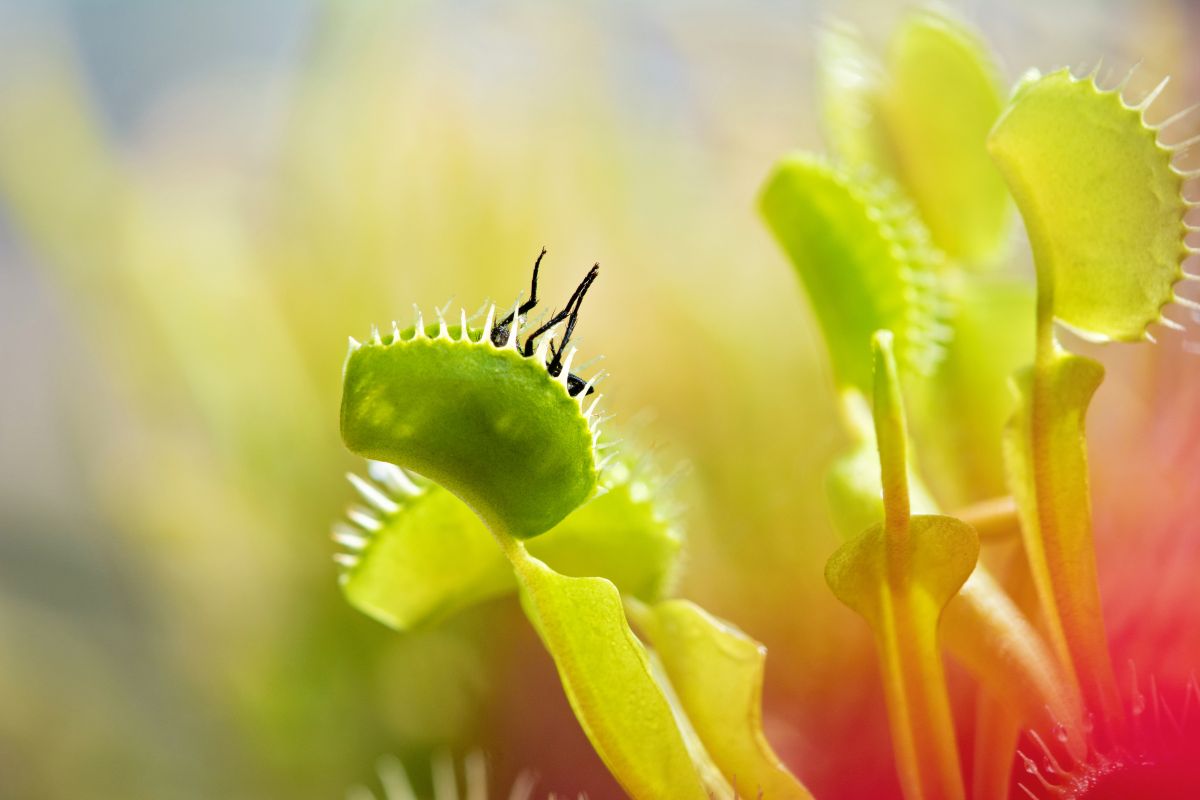
One of the most exciting aspects of raising a Venus Flytrap is feeding it. But overfeeding the Venus Flytrap can be lethal.
Venus Flytraps are capable of photosynthesis, where they produce their energy thanks to sunlight. When trapping and digesting prey, they acquire extra nutrients. Not feeding a plant at all can weaken it, but will rarely kill it. If your plant is outdoors, it will catch prey by itself when it needs to eat.
Indoors, traps should only be fed one at a time and the amount of time between one feeding and the next needs to be respected. After you have fed a trap, you should wait several weeks because the feeding of one trap sufficiently nourishes the entire plant.
Feed your plant approximately once a month. If you are in doubt, wait until it has thoroughly digested all the bugs before offering a new one for dinner. During dormancy, the plant should not be fed at all.
Venus Flytraps can be fed either live or dead bugs, and these plants can consume a wide variety of bugs and arachnids
Learn more about How Often to Feed Venus Flytraps.
7. Eating Something That Is Too Big
An insect may be too large for a particular trap to consume. When bugs are too big, the trap will not be capable of digestion. As a result, the plant will let the trap with the oversized prey wither and turn black.
A general rule to follow is to only feed bugs that measure one-third of the trap’s size. If your bugs are too large, cut them up and feed them as small pieces.
These plants do not require larger bugs for their survival. The prey they consume gives a boost nutritionally to the plant, so when a bug is caught and consumed, it will generally satisfy your Venus Flytrap for roughly a month.
8. Moving or Repotting Stress
Venus Flytrap plants are easily stressed. This can be due to the environment or to people. With undo stress, leaves will turn black. Your plant should be located in a spot without strong winds. This will include fans, vents, and door and window drafts. Winds may stress your plant, causing leaf drop.
Also, refrain from touching your plant unless you have a good reason. This can stress your plant as well. For example, touching the traps to make them close and open.
9. Poor Lighting
Venus Flytraps need lots of light to grow successfully and thrive. In the best conditions, they will receive 12 hours of sunshine daily. Should your plant receive four hours or less of sunlight, it will gradually weaken and suffer light deprivation, essentially starving from a lack of light.
Traps will begin to fade, and the leaf edges may blacken. If you do not have access to bright light, use a grow light or LED light to supplement your plant’s needs. Also, fluorescent lights with a higher output are suitable.
Learn more about Venus Fly Trap Lighting Needs.
10. Wrong Water Source or Water Quantity
Using the incorrect type of water or underwatering your plant will cause the leaves to dry out, turning traps black and killing the plant rapidly.
Your Venus Flytrap requires generous watering because the soil bed should remain moist at all times. An incorrect type of water can kill your plant. Both tap water and bottled water should never be used to water this plant. The best water types to use are distilled water, rainwater, or filtered or reverse osmosis water.
If by chance, you have used the wrong type of water, repot your Venus Flytrap immediately with a new, fresh growing medium. The minerals contained in other water types like tap water or bottled mineral water will burn roots and prove to be lethal.
If you have trouble with keeping a watering schedule, consider placing a dish underneath your plant’s container to provide extra water when necessary. The container should have drainage holes to allow excess water to drain out.
Read more about Proper Watering for Venus Flytrap.
Why is My Venus Fly Trap Turning Black in Summer?
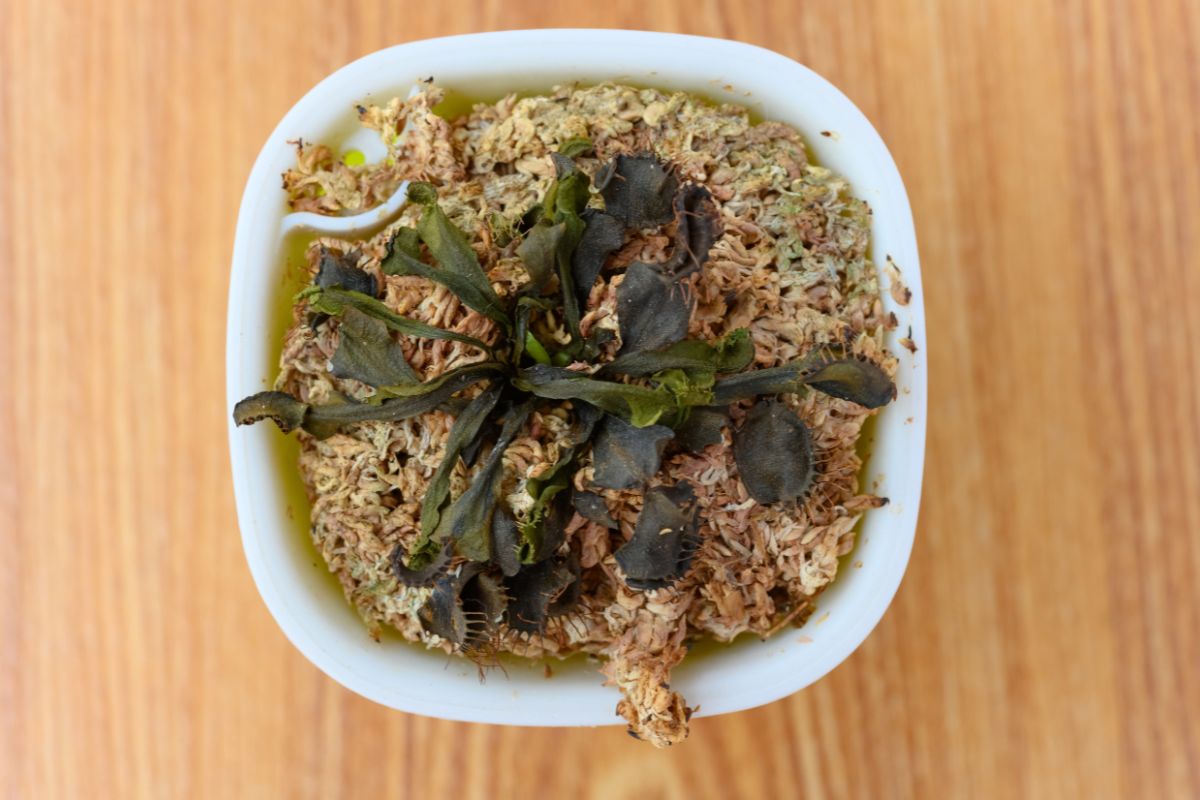
If the summer season kicks off your Venus Fly Trap turning black during the summer, a few different factors might be at play:
- Natural Leaf Die-Off: It’s completely normal for a Venus Flytrap to have a few black traps at any given time. The leaves of these plants have a lifespan of about a month or so, after which they naturally turn black and die off. As long as it’s just a few traps and the rest of the plant looks healthy, there’s no need to worry.
- Overfeeding: Venus Flytraps don’t need to be constantly fed. If a trap is fed more than it can handle, or if it’s fed something inappropriate like human food, the trap can turn black and die.
- Incorrect Water: Venus Flytraps are very sensitive to the minerals and chemicals found in tap water. Always use distilled water or rainwater.
- Sunburn: Just like people, plants can get sunburned too! If your Venus Flytrap has recently been moved to a location with significantly more direct sunlight, it may be suffering from sunburn.
- Disease or Pests: If the entire plant is turning black and looking unhealthy, it could be a sign of a fungal disease or pest infestation.
If you’re unsure, it’s always a good idea to consult with a local nursery or extension service. They can often provide advice specific to your situation and local conditions. Remember, the key to healthy plants is providing the right conditions and observing closely for any changes.
Why is My Venus Flytrap Turning Black After Feeding?
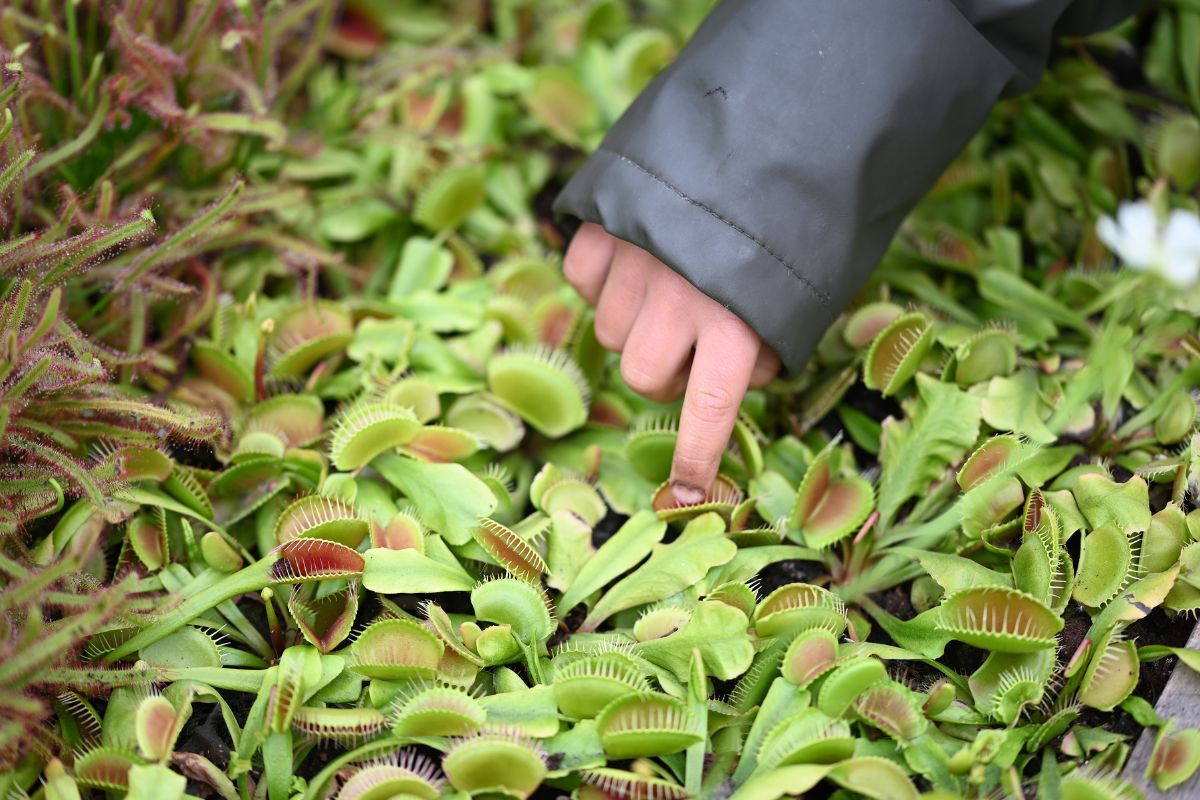
If your Venus Flytrap is turning black after feeding, it could be due to a few reasons:
- Overfeeding: Venus Flytraps don’t need to eat very often. In fact, each individual trap can only close and reopen a few times during its lifetime. If a trap is constantly being triggered to close, or if it’s fed too large a meal, it can exhaust itself and turn black.
- Inappropriate Food: Venus Flytraps are designed to digest small insects and spiders. If they’re fed something else—like human food or large, hard insects—it can cause the trap to turn black. The food might be too large for the trap to fully close around, allowing bacteria to get in and start decomposing the food (and the trap itself).
- Improper Feeding Technique: If you’re feeding your Venus Flytrap manually, be careful not to damage the delicate inner surfaces of the trap. Using forceps or tweezers can accidentally injure the trap, causing it to blacken.
Remember, a Venus Flytrap doesn’t need to eat very often. One or two meals per month is plenty.
And it’s perfectly normal for traps to turn black and die off naturally after they’ve done their job. As long as the rest of the plant is green and healthy, there’s no cause for concern.
But if you see widespread blackening or other signs of distress, it might be time to revisit your care routine or consult with a plant expert.
Should I Remove a Black Venus Flytrap?
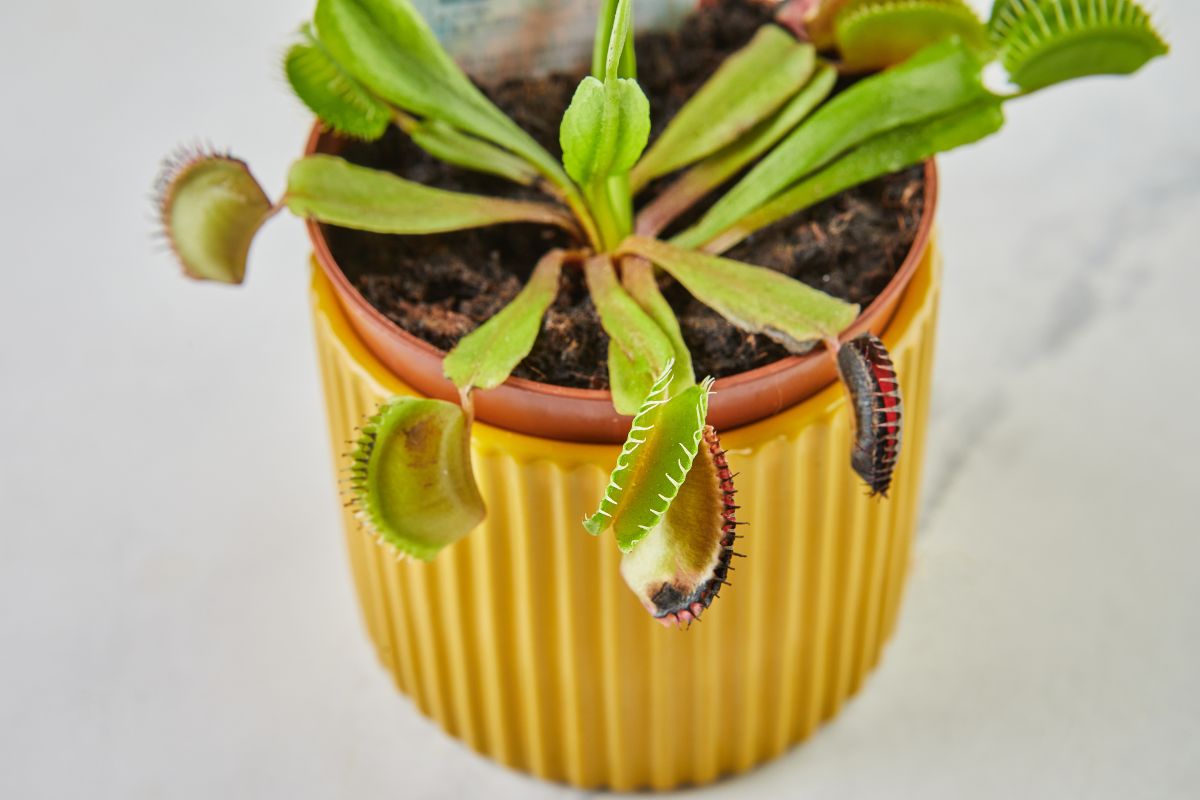
Yes, remove any Venus Fly Trap black leaves. While the black color is not contagious and will not move from one leaf to the next, it will stress the plant with its presence.
When a leaf begins to blacken, do not remove it immediately, but instead wait until it withers completely. When a leaf is only partially black, for example along the edges or at the base, it can still contribute to photosynthesis. Once the leaf has completely withered, trim it off.
The only exception to this is if the trap has a bug inside. A dead bug left in a trap that has begun to wither can attract bacteria or fungus. It may smell as well. Trim a trap with a bug as soon as it begins to wither.
Here are the steps to remove black leaves:
- Prune your leaf as close to the bulb as possible with sharp scissors.
- Never pull on dead leaves as you may damage the bulb and root.
- Avoid triggering traps. Hold only the black leaves that require trimming.
- If there is more than one black leaf, trim them at the same time to limit stress on the plant.
Venus Flytrap Turning Black Final Thoughts
For every black trap, you should notice a new one emerging. If you notice an increased number of black leaves, determine the cause, and take steps to protect your plant.
To keep your plant healthy, monitor your plants regularly and take care of them.
Here are Venus Flytrap care articles to help you keep your plants healthy:

